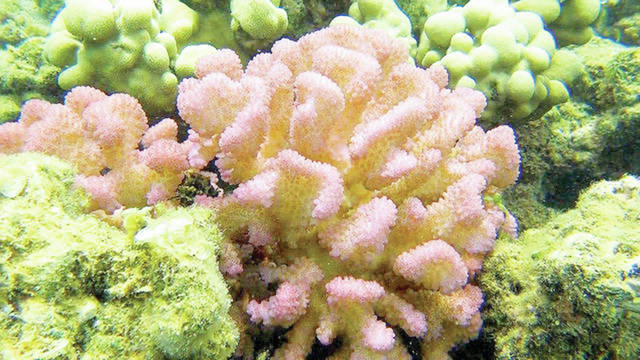LIHUE — There are bright spots in the world’s coral reefs, places where corals are thriving even though scientists say we’ve lost half the world’s reefs in the last three decades.
And reefs in Hawaii are among the 38 coral reef ‘oases’ identified by University of Hawaii researcher and director of Hawaii Institute of Marine Biology Ruth Gates and her in a paper recently published in the Journal of Applied Sciences.
“Coral reefs are in rapid, global decline,” said Dan Thornhill, program director in the National Science Foundation’s Division of Ocean Sciences, which funded a portion of the investigations upon which the study is based. “This timely and much-needed paper identifies coral reefs that are doing better than most, places that may provide a refuge against the worst effects of climate change.”
The study compiled data from 123 survey sites taken over the past 11 years or longer from four regions: Hawaiian Islands, Florida Keys, Moorea, French Polynesia, and St. John, U.S. Virgin Islands.
On Kauai, data was taken at Limahuli, Milolii, Nualolo Kai and Hanalei on the North Shore and at Hoai Bay across from Prince Kuhio Park in Koloa.
“Over the last 12 to 24 months, damage to coral reefs worldwide has appeared at an alarming rate, with deaths driven by the most recent El Nino, compounded by climate change induced ocean warming” said California State University biologist and leader of the study, Peter Edmunds.
Edmunds continued: “But there are still places that are doing surprisingly well. These coral reef oases focus the attention on environments and communities that can help enhance coral conservation efforts.”
As the team of 18 scientists complied decades of data, they consolidated coral reef ‘oases’ into three categories: escape oases that have been thriving, resist oases that appear hardy and able to resist environmental changes, and rebound oases that have suffered damage and rebounded.
The coral in Anini Bay and at Waipa on Kauai are examples of rebounding reefs according to the scientists and underwater enthusiasts that visit the reef.
Tom Woods and Robin Mazor with Reef Guardians Hawaii reported new corals starting at both locations in March 2017.
A year later, reports of coral regrowth in Anini Bay came in from Terry Lilley, who has been shooting underwater footage in the area for more than five years.
“Corals were all disease free and continuing to grow at a rapid rate,” he told TGI.
The new framework developed by Gates, Edmunds and the rest of their team can help further identify areas that have remained unaffected or are bouncing back.
Their framework considers the health of coral communities, how often they had been disturbed, and how long they had remained in a healthy or unhealthy state.
Gates said she has been “blown away by the capacity of the some badly damaged reefs in Hawaii to recover from past disturbances. There are areas in Hawaii which are remarkable example of oases.”
Given the 38 oases the researchers have identified, Edmunds said it is logical to assume that there are more coral oases in the rest of the world’s oceans.
“We are optimistic that our coral reef oases are signs of hope for the future, rather than the last gasp of a dying ecosystem,” he said.
The framework will help policymakers to identify areas that warrant stronger protection or specific management strategies, according to UH, as these intact ecosystems may be able to catalyze broader ecosystem recovery.



Don’t forget the coral survived the heavy runoff of the 80s which included Cane runoff.
Looks like the Navy has stopped using their low frequency sonar. Must be, ya Terry?